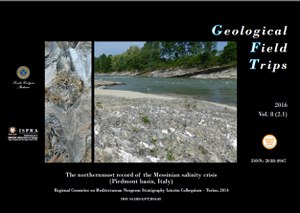The northernmost record of the Messinian salinity crisis (Piedmont basin, Italy)
Regional Commitee on Mediterranean Neogeone Stratigraphy Interim Colloquium – Torino, 2014
The aim of the field trip, regarding the southern (Langhe) and northern (Monferrato) part of the Tertiary Piedmont basin, is the description of the stratigraphical and sedimentological setting of the Messinian succession, which records the events of the Messinian salinity crisis (MSC). In the frame of this strongly debated scientific topic, the Piedmont basin is of particular interest, since it preserves the northernmost record of the MSC. The first two stops, located at the northernmost edge of the Langhe basin, allow the reconstruction of the lateral facies transition between a marginal (Stop 1) and a deeper sector (Stop 2) of the Messinian basin. The onset of the MSC is not marked here by an evaporite layer (as observed in other sectors of the MSC) but rather by peculiar laminated carbonate beds that are considered as the product of lithification of microbial mats dominated by sulphide-oxidizing bacteria (Stop 1). In the deeper sector of the basin (Stop 2) no sedimentological or lithological evidence can be observed at the MSC onset, which is recorded within a sequence of hemipelagic muds deposited on an oxygen-depleted sea bottom. The onset of the deposition of primary evaporites is strongly diachronous and more and more recent toward the deeper part of the basin. These primary evaporites consist of bottom-grown selenite and laminated microcrystalline gypsum (“cumulate gypsum”), which forms distinct beds regularly alternated to mudstone layers. These mudstone/gypsum couplets result from precession-controlled humid/arid climate oscillations with a periodicity of about 21 Ka. Primary evaporites are sharply followed, through a basin scale erosional unconformity, by resedimented and clastic gypsum facies, deposited in response of the tectonic deformation of the basin margins. The basal unconformity corresponds to the Messinian erosional surface, dated at 5.60 Ma. The Messinian succession ends with fluvio-deltaic terrigenous sediments, with continental vertebrate fossil assemblages, followed by brackish water marls which record the Lago Mare event at the end of the MSC, prior to the sudden return to normal marine conditions at the base of the Zanclean. In the northern margin of the Piedmont basin (Monferrato), the Messinian succession consists of chaotic deposits (huge gypsum blocks floating in a fine-grained matrix) which are the product of large scale mass wasting events related to the tectonic deformation of the Monferrato (Stop 3). The field trip ends in a quarry exposing a chaotic succession enclosing various types of methane-derived carbonate rocks (Stop 4). This succession is interpreted as the geological record of a Messinian submarine mud volcano.
DOI: 10.3301/GFT.2016.03

